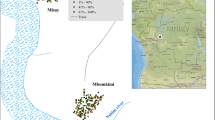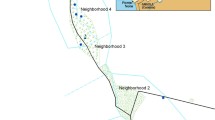Abstract
Aim
Lymphatic filariasis is an important public health problem that causes economic loss and poverty in many endemic regions of India. This study explores the influence of socioeconomic factors on filariasis prevalence in the Chittoor district of Andhra Pradesh.
Subjects and methods
To understand the influence of socioeconomic variables on lymphatic filariasis, a pilot-scale epidemiological and socioeconomic study was conducted in 30 villages of Chittoor district, Andhra Pradesh, India, from 2004 to 2007. Data were analyzed statistically by frequency distribution, multivariate logistic regression and principal component analysis (PCA).
Results
A total of 5133 blood samples were collected and screened for microfilaria; 77 were found to be positive (1.52 %). The multivariate analysis showed that variables such as age (OR = 2.4, 95 % CI: 1.47–4.01), income [Indian rupees (INR): <1000: OR = 4.2, 95 % CI: 1.48–11.76; INR: 1000–3000: OR = 3.84, 95 % CI:1.92–7.68], drainage system (OR = 3.5, 95 % CI: 1.62–7.5), mosquito avoidance (OR = 1.41, 95 % CI: 0.69–2.87) and participation in mass drug administration (MDA) programs (OR = 1.33, 95 % CI:0.74–2.38) were risk factors for filariasis. The socioeconomic index derived from the PCA was categorized into low (1.7 %), medium (1.7 %) and high (1.3 %) in relation to the percentage of parasite prevalence.
Conclusion
This study reveals that filariasis is largely associated with various socioeconomic factors. Hence, health officials should focus on improving the quality of life to minimize the filarial incidence in the endemic villages by considering the socioeconomic index as a marker for targeting low and medium socioeconomic level groups for disease control programs.


Similar content being viewed by others
References
Aguiar-Santos AM, Medeiros Z, Bonfim C, Rocha AC, Brandão E, Miranda T, Oliveira P, Sarinho ES (2013) Epidemiological assessment of neglected diseases in children: lymphatic filariasis and soil-transmitted helminthiasis. J Pediatr (Rio J) 89:250–255
Ahorlu CK, Dunyo SK, Koram KA, Nkrumah FK, Aagaard-Hansen J, Simonsen PE (1999) Lymphatic filariasis related perceptions and practices on the coast of Ghana: implications for prevention and control. Acta Trop 73:251–261
Azab SF, Sherief LM, Saleh SH, Elsaeed WF, Elshafie MA, Abdelsalam SM (2014) Impact of the socioeconomic status on the severity and outcome of community-acquired pneumonia among Egyptian children: a cohort study. Infect Dis Poverty 3:14
Babu BV, Kar SK (2004) Coverage, compliance and some operational issues of mass drug administration during the programme to eliminate lymphatic filariasis in Orissa, India. Trop Med Int Health 9:702–709
Babu BV, Mishra S (2008) Mass drug administration under the programme to eliminate lymphatic filariasis in Orissa, India: a mixed-methods study to identify factors associated with compliance and non-compliance. Trans R Soc Trop Med Hyg 102:1207–1213
Babu BV, Mishra S, Nayak AN (2009) Marriage, sex, and hydrocele: an ethnographic study on the effect of filarial hydrocele on conjugal life and marriage ability from Orissa, India. PLoS Negl Trop Dis 3:e414
Baruah K, Rai RN (2000) The impact of housing structures on filarial infection. Jpn J Infect Dis 53:107–110
Bockarie MJ, Molyneux DH (2009) The end of lymphatic filariasis? BMJ 338:b1686
Bonfim C, Netto MJ, Pedroza D, Portugal JL, Medeiros Z (2009) A socioenvironmental composite index as a tool for identifying urban areas at risk of lymphatic filariasis. Trop Med Int Health 14:877–884
Boyd A, Won KY, McClintock SK, Donovan CV, Laney SJ et al (2010) A community-based study of factors associated with continuing transmission of lymphatic filariasis in Leogane, Haiti. PLoS Negl Trop Dis 4
Cano J, Rebollo MP, Golding N, Pullan RL, Crellen T, Soler A, Kelly-Hope LA, Lindsay S, Hay SI, Bockarie MJ, Brooker SJ (2014) The global distribution and transmission limits of lymphatic filariasis: past and present. Parasit Vector 7:466. doi:10.1186/s13071-014-0466-x
Charu Kohli, Rajesh Kumar, Meena GS, Singh MM, Jyotiranjan Sahoo, Ingle GK (2014) Usage and perceived side effects of personal protective measures against mosquitoes among current users in Delhi. J Parasitol Res 628090
Durrheim DN, Wynd S, Liese B, Gyapong JO (2004) Editorial: Lymphatic filariasis endemicity—an indicator of poverty? Trop Med Int Health 9:843–845
Erlanger TE, Keiser J, Caldas De Castro M, Bos R, Singer BH, Tanner M, Utzinger J (2005) Effect of water resource development and management on lymphatic filariasis, and estimates of populations at risk. Am J Trop Med Hyg 73:523–533
Filmer D, Pritchett LH (2001) Estimating wealth effect without expenditure data or tears: an application to educational enrolments in States of India. Demography 38:115–132
Ghosh S, Samanta A, Kole S (2013) Mass drug administration for elimination of lymphatic filariasis: recent experiences from a district of West Bengal, India. Trop Parasitol 3:67–71
Haddix AC, Kestler A (2000) Lymphatic filariasis: economic aspects of the disease and programmes for its elimination. Trans R Soc Trop Med Hyg 94:592–593
Litt E, Baker MC, Molyneux D (2012) Neglected tropical diseases and mental health: a perspective on comorbidity. Trends Parasitol 28:195–201
Lynch J, Kaplan G (2000) Socioeconomic position. In: Berkman L, Kawachi I (eds) Social epidemiology. Oxford University Press, Oxford, pp 13–35
Michael E, Bundy DAP (1997) Global mapping of lymphatic filariasis. Parasitol Today 13:472–476
Mishra A, Bhadoriya RS (2009) An epidemiological study of filariasis in a village of District Datia, MP. Indian J Community Med 34:202–205
Molyneux DH (2003) Lymphatic filariasis (elephantiasis) elimination: a public health success and development opportunity. Filaria Journal 2:13
Mukhopadhyay AK, Patnaik SK, Satya Babu P, Rao KNMB (2008) Knowledge on lymphatic filariasis and mass drug administration (MDA) programme in filaria endemic districts of Andhra Pradesh, India. J Vector Borne Dis 45:73–75
Murty US, Rao MS, Sriram K, Rao KM (2010) Assessment of microfilaria prevalence in Karimnagar and Chittoor Districts of Andhra Pradesh, India. Asian Pacific J Trop Med 3:647–650
Mwakitalu ME, Malecela MN, Pedersen EM, Mosha FW, Simonsen PE (2013) Urban lymphatic filariasis in the metropolis of Dar es Salaam, Tanzania. Parasit Vector 6:286
NVBDCP (2004) Operational guidelines on elimination of lymphatic filariasis. Directorate of National Vector Borne Disease Control Programme, New Delhi p10
Okon OE, Iboh CI, Opara KN (2010) Bancroftian filariasis among the Mbembe people of Cross River state, Nigeria. J Vector Borne Dis 47:91–96
Ottesen EA, Molyneux D (2006) Lymphatic filariasis: treatment, control and elimination. Adv Parasitol 61:395–441
Ottesen EA, Hooper PJ, Bradley M, Biswas G (2008) The global programme to eliminate lymphatic filariasis: health impact after 8 years. PLoS Negl Trop Dis 2:e317
Perera M, Whitehead M, Molyneux D, Weerasooriya M, Gunatilleke G (2007) Neglected patients with a neglected disease? A qualitative study of lymphatic filariasis. PLoS Negl Trop Dis 1:e128
Ramaiah KD (2013) Population migration: implications for lymphatic filariasis elimination programmes. PLoS Negl Trop Dis 7:e2079
Rath K, Nath N, Shaloumy M, Swain BK, Suchismita M, Babu BV (2006) Knowledge and perceptions about lymphatic filariasis: a study during the programme to eliminate lymphatic filariasis in an urban community of Orissa, India. Trop Biomed 23:156–162
Schofield CJ, White GB (1984) Housing design and domestic vectors of disease. Trans R Soc Trop Med Hyg 78:285–292
Testi A, Ivaldi W (2009) Material versus social deprivation and health: a case study of an urban area. Eur J Health Econ 10:323–328
Thrane N, Sondergaard C, Schonheyder HC, Sørensen HT (2005) Socioeconomic factors and risk of hospitalization with infectious diseases in 0- to 2-year-old Danish children. Eur J Epidemiol 20:467–474
Upadhyayula SM, Mutheneni SR, Kadiri MR, Kumaraswamy S, Nagalla B (2012a) A cohort study of lymphatic filariasis on socio economic conditions in Andhra Pradesh, India. PLoS ONE 7:e33779
Upadhyayula SM, Mutheneni SR, Kumaraswamy S, Kadiri MR, Pabbisetty SK, Yellepeddi VS (2012b) Filaria monitoring visualization system: a geographical information system–based application to manage lymphatic filariasis in Andhra Pradesh India. Vector-Borne Zoonot Dis 12:418–427
Webb DJ (1985) Low-cost housing and parasite vectors. Parasitol Today 1:65–66
WHO (2000) Eliminate filariasis: attack poverty. proceedings of the first meeting of the global alliance to eliminate lymphatic filariasis. WHO, Geneva
WHO (2002) Lymphatic filariasis: the disease and its control. fifth report of the WHO expert committee on filariasis. WHO, Geneva
WHO (2009) Global programme to eliminate lymphatic filariasis. Wkly Epidemiol Rec 84:437–444
WHO (World Health Organisation) (1992) Lymphatic filariasis: the disease and its control. fifth report of the WHO Expert Committee on filariasis. World Health Organ Tech Rep Ser 821:1–71
Acknowledgments
We thank the Director, Council of Scientific and Industrial Research, Indian Institute of Chemical Technology, for her encouragement and support. Thanks go to the Ministry of Communication and Information Technology (MC&IT), Government of India, for funding the project.
Conflict of interest
The authors declare that they have no conflicts of interests.
Author information
Authors and Affiliations
Corresponding author
Rights and permissions
About this article
Cite this article
Mutheneni, S.R., Upadhyayula, S.M., Kumaraswamy, S. et al. Impact of socioeconomic factors on the prevalence of lymphatic filariasis in Andhra Pradesh, India. J Public Health 23, 231–240 (2015). https://doi.org/10.1007/s10389-015-0673-8
Received:
Accepted:
Published:
Issue Date:
DOI: https://doi.org/10.1007/s10389-015-0673-8




